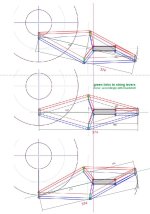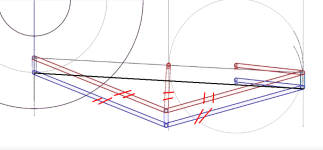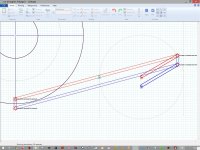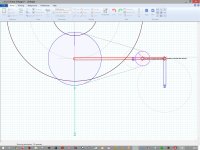It can be more simple, and then we arrive at the topology of my 3-pivot tonearm:another step?
Hi Alighiszem: checking your simplification I saw that, giving up some more precision, it's possible to throw away some more lever. while respecting Peaucellier's constants and variables
Attachments
The triangle is unnecessary.and step by step...
...a long, long walk could draw to a true pivoted linear, no more complicated than some high end ones?
carlo
It can be more simple, and then we arrive at the topology of my 3-pivot tonearm:
So you just have to build it, and show us it at work.
The triangle is unnecessary.
How? Imho the "triangle" is the part of Peacellier's rhombus indispensable for transforming the linear motion into a rotation, (even if not perfectly and just for the tracking area). Without it, there remains only a parallelogram which is unable to do so. Just from linear to linear.
But i'm anxious to see how it could work on a simulation
carlo
Perhaps from the simulation #5020 it is not understood that the long levers are not hinged in the center
So you just have to build it, and show us it at work.
The triangle is unnecessary.
How? Imho the "triangle" is the part of Peacellier's rhombus indispensable for transforming the linear motion into a rotation, (even if not perfectly and just for the tracking area). Without it, there remains only a parallelogram which is unable to do so. Just from linear to linear.
But i'm anxious to see how it could work on a simulation
carlo
Perhaps from the simulation #5020 it is not understood that the long levers are not hinged in the center
Since I live with doubts instead of other's certainties, I tried the simulation myself:
- with unlinked levers the simulation doesn't start,
- with linked levers the program itself even freezes.
now I'm even more curious
c
- with unlinked levers the simulation doesn't start,
- with linked levers the program itself even freezes.
now I'm even more curious
c
Attachments
You are right.
I made a snap judgement.
The "no triangle" version would work only if the pivot in the middle would slide too.
I made a snap judgement.
The "no triangle" version would work only if the pivot in the middle would slide too.
Show me how pls -
Understanding the implications of a Peucellier cell and how to handle them is far from instinctive, I had to spend time investigating and reading, to avoid trivial mistakes.
Eliminating some levers and joints sounds promising, but it's not. Mathematicians have shown that 8 levers are needed for an inversive geometry, using less it becomes approximate.
And thinking on how to manage those long, unsupported cantilevers in a real TA, the desire to use them disappears immediately.
So if someone knew how to make a "no-play-no-friction" triple joint bearing, a prototype of the #5018 simulation could be mandatory to clarify some basic doubts.
c
...
Understanding the implications of a Peucellier cell and how to handle them is far from instinctive, I had to spend time investigating and reading, to avoid trivial mistakes.
Eliminating some levers and joints sounds promising, but it's not. Mathematicians have shown that 8 levers are needed for an inversive geometry, using less it becomes approximate.
And thinking on how to manage those long, unsupported cantilevers in a real TA, the desire to use them disappears immediately.
So if someone knew how to make a "no-play-no-friction" triple joint bearing, a prototype of the #5018 simulation could be mandatory to clarify some basic doubts.
c
...
The double Peaucellier cell is overdetermined. It has more parts than needed for the funkction. #5011 is enough
My remark in #5027 refers exclusively to the toplogy in #5020.
And no, I will not show how to do it.
You are on your own.
.
My remark in #5027 refers exclusively to the toplogy in #5020.
And no, I will not show how to do it.
You are on your own.
.
And no, I will not show how to do it. You are on your own.
...on my own? Strange.
because all the tonearms I've made (more than a dozen by now, and not simple copycats) owe to ideas, knowledge, hints, collaborations, and also reasoned criticisms of true masters, which i consider as true friends.
Here I have simply collected some materials and hypothesis probably new, probably wrong for LTA design. The rest is simply "trial and error", as usual to go ahead in every kind of work.
ciao carlo
...on my own? Strange.
because all the tonearms I've made (more than a dozen by now, and not simple copycats) owe to ideas, knowledge, hints, collaborations, and also reasoned criticisms of true masters, which i consider as true friends.
Here I have simply collected some materials and hypothesis probably new, probably wrong for LTA design. The rest is simply "trial and error", as usual to go ahead in every kind of work.
ciao carlo
Hi Alighiszem and all, surely the point of these threads is to help and show others, thats why its open forum, i have gained enormously from that, i don't understand all this well, but would be delighted to see your solutions to this intriguing idea.The double Peaucellier cell is overdetermined. It has more parts than needed for the funkction. #5011 is enough
My remark in #5027 refers exclusively to the toplogy in #5020.
And no, I will not show how to do it.
You are on your own.
.
M
My early attempt at a pivoting LT.
Deviation from linearity better than 0.174 mm, deviation from tangentiality better than 0,2 degree.
Deviation from linearity better than 0.174 mm, deviation from tangentiality better than 0,2 degree.
Are you telling us that the angle A in the following diagram is smaller than 0.2 degrees? Do you understand why Carlo had to use double structures for his model?deviation from tangentiality better than 0,2 degree.
Jim, I have replicated the simulation, and in my opinion with that pulley ratio its' alignment is perfect.
(cute mechanism - congratulations, Alighiszem),
But I don't understand well how it works, since in our sad world it's not the tone arm that moves the cartridge, but vice versa.
carlo
(cute mechanism - congratulations, Alighiszem),
But I don't understand well how it works, since in our sad world it's not the tone arm that moves the cartridge, but vice versa.
carlo
Attachments
Carlo,Jim, I have replicated the simulation, and in my opinion with that pulley ratio its' alignment is perfect.
(cute mechanism - congratulations, Alighiszem),
I don't think none of Alighiszem's models works. The reason is very simple. Let's go back to the basics of the modern cartridge.
The stylus of almost all modern cartridges is a line contact stylus. Even for an elliptical stylus, it is not non-directional. Only the conical stylus is non-directional. However, I am not sure if a conical stylus may work with Alighiszem's models. Further study is needed.
Let's take the micro ridge stylus profile as an example.
In situation A, the stylus is tangential to the groove. Where the red dot line is colinear with the black dot line. There is no tracking error in situation A.
In situations B and C, the stylus is NOT tangential to the groove and there is a tracking error although the stylus does make linear movement from X to Y.
Now, let's examine Alighiszem's models.
There is only one point in the middle where the stylus is tangential to the groove. In the rest areas, there are tracking errors although the center of the stylus makes linear movements. The tracking errors may be even larger than the tracking errors of a regular pivot arm. How could he say that deviation from tangentiality is better than 0,2 degrees? That doesn't make sense at all.
All his models don't work without additional mechanisms to ensure the stylus tangential to the groove. His models are not true linear tonearms.
Jim
Carlo, you must have made some error.
The parts are connected unambiguously and reciprocal so it must not make any difference on which side the moving force is.
The parts are connected unambiguously and reciprocal so it must not make any difference on which side the moving force is.
Hi Jim. quote your observations on modern tip cuts, but what does that have to do with the accuracy of this model?
Since some time ago (Angling fo 90° #1601) I had designed the Rabbit, a belted PLT, maybe I know what is needed to understand how pulleys + belt work, and my verification on Linkage2 confirms that the Alighiszem geometry is absolutely impeccable as far as alignments are concerned. I advise you to repeat it yourself - the role of the pulleys seem neglected in your drawing.
Carlo, you must have made some error.
HI Alighiszem
maybe, but try yourself to use, instead of the "rotating input anchor", a "linear actuator" put in SF or SD direction. This way, much nearer to real behavior, my sim locks up when the joints get aligned horizontally (as if the SF is dissipated on vertical lever constraint)
Since some time ago (Angling fo 90° #1601) I had designed the Rabbit, a belted PLT, maybe I know what is needed to understand how pulleys + belt work, and my verification on Linkage2 confirms that the Alighiszem geometry is absolutely impeccable as far as alignments are concerned. I advise you to repeat it yourself - the role of the pulleys seem neglected in your drawing.
Carlo, you must have made some error.
HI Alighiszem
maybe, but try yourself to use, instead of the "rotating input anchor", a "linear actuator" put in SF or SD direction. This way, much nearer to real behavior, my sim locks up when the joints get aligned horizontally (as if the SF is dissipated on vertical lever constraint)
Sorry - I hadn't noticed it on youtube low res
Re-checked the alignments and applied to the geometry with the original pulleys (I had reduced them, with the same ratio) but it continues to lock up in the same position. I'll send you the sim file because I can't find the error.
Unfortunately on algadoo i'm unable to simulate belt + pulleys (is it possible?) - it would be interesting to see vectors in action. Have you already done a mock up?
c
Re-checked the alignments and applied to the geometry with the original pulleys (I had reduced them, with the same ratio) but it continues to lock up in the same position. I'll send you the sim file because I can't find the error.
Unfortunately on algadoo i'm unable to simulate belt + pulleys (is it possible?) - it would be interesting to see vectors in action. Have you already done a mock up?
c
Attachments
- Home
- Source & Line
- Analogue Source
- DIY linear tonearm




